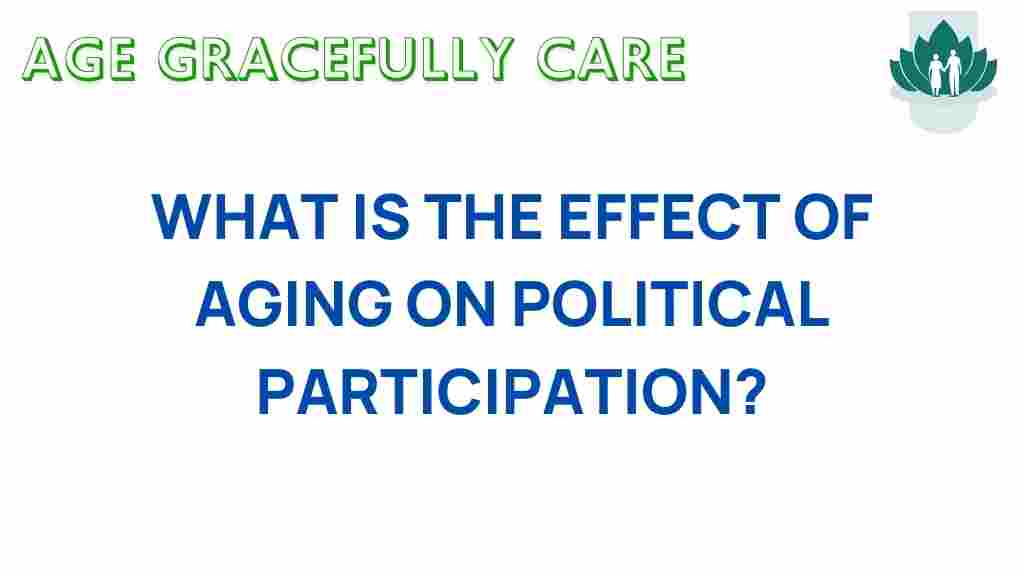Unraveling the Impact of Aging on Political Participation
The intersection of aging and political participation is a topic of increasing relevance in today’s rapidly changing societal landscape. Understanding how different age groups engage in civic activities and how demographic shifts influence voter turnout is crucial for predicting election trends and shaping future political strategies. This article will delve into the relationship between aging, political participation, and various factors that drive voter behavior, providing insights into generational shifts and social influences that impact civic engagement.
The Aging Population and Its Implications for Voter Turnout
As populations around the world age, the implications for political participation become more pronounced. Aging affects not only the demographics of a region but also the motivations and abilities of individuals to engage in civic activities. Here are some key points to consider:
- Demographics: The proportion of older adults in the population is steadily increasing. In many countries, this shift is accompanied by a decrease in the younger demographic, which alters the traditional voting landscape.
- Civic Engagement: Older citizens often exhibit different patterns of civic engagement compared to their younger counterparts. They may have more time to participate in political activities but can also face barriers such as health issues or mobility challenges.
- Voter Turnout: Historically, older adults have demonstrated higher voter turnout rates compared to younger age groups. This trend highlights the importance of understanding their motivations and concerns.
Generational Shifts and Their Effects on Political Participation
Generational shifts play a significant role in shaping political participation. Each generation brings unique values, experiences, and priorities that influence their approach to civic engagement. Here are some notable trends:
- Baby Boomers: This generation has been known for its active participation in political movements, and they tend to maintain high levels of engagement as they age.
- Generation X: Often sandwiched between Baby Boomers and Millennials, this group has shown fluctuating levels of engagement, with a tendency to prioritize issues like economic stability and social justice.
- Millennials and Generation Z: These younger generations have been characterized by their use of technology and social media to mobilize and engage politically. However, they often face challenges in voter turnout, influenced by societal factors and disillusionment with the political system.
Social Influence on Voter Behavior
Social factors significantly influence how individuals engage in political activities. Aging individuals often experience changes in their social networks, which can impact their political participation. Key factors include:
- Community Engagement: Older adults often have established community ties that can foster a sense of responsibility to vote and participate in civic activities.
- Peer Influence: Social circles can encourage or discourage political participation. Older adults who are surrounded by politically active peers are more likely to engage in voting and advocacy.
- Family Dynamics: Family discussions about politics can shape attitudes toward civic engagement. Older adults may find themselves more politically engaged if their family members prioritize voting.
Step-by-Step Process: Increasing Political Participation Among Older Adults
To enhance political participation among the aging population, several strategies can be implemented:
- Education and Awareness: Provide accessible information about the voting process, including how to register, vote by mail, or utilize early voting options.
- Community Programs: Develop local programs that encourage civic engagement, such as forums, workshops, and discussion groups focused on relevant political issues.
- Transportation Solutions: Offer transportation assistance to help older adults reach polling places, ensuring they have the means to participate in elections.
- Leveraging Technology: Use technology to reach older voters through online platforms, webinars, and social media, making information about political participation more accessible.
Troubleshooting Tips for Barriers to Participation
While many older adults are eager to participate in political activities, they may encounter barriers that hinder their engagement. Here are some common issues and suggestions for overcoming them:
- Health Issues: Ensure that accommodations are made for individuals with mobility challenges, such as providing accessible polling locations or mail-in voting options.
- Complex Registration Processes: Simplify the voter registration process by offering assistance and clear instructions, both online and in-person.
- Information Overload: Provide straightforward, unbiased information about candidates and issues to help older adults make informed decisions without feeling overwhelmed.
Election Trends and the Future of Political Participation
As the demographics of voters continue to shift, we can anticipate several trends that will shape future political participation:
- Increased Diversity: As the population ages, it will become more diverse, leading to a broader range of perspectives and priorities in political discourse.
- Technology Integration: The increasing reliance on technology for communication and information dissemination will likely influence how older adults engage with political content.
- Focus on Key Issues: Aging populations may prioritize specific issues such as healthcare, social security, and retirement benefits, driving them to participate in elections more actively.
Conclusion
Understanding the impact of aging on political participation is essential for fostering a more inclusive democracy. As the population ages, recognizing the unique characteristics and needs of older voters is crucial for enhancing voter turnout and civic engagement. By addressing barriers and leveraging social influences, we can create a political landscape that encourages active participation from all age groups. The future of political participation will depend on our ability to adapt to demographic changes and engage individuals through meaningful, relevant channels.
For more insights into civic engagement trends, you can visit this resource. To explore the relationship between demographics and political behavior further, check out this study.
This article is in the category Wellness and created by AgeGracefullyCare Team
